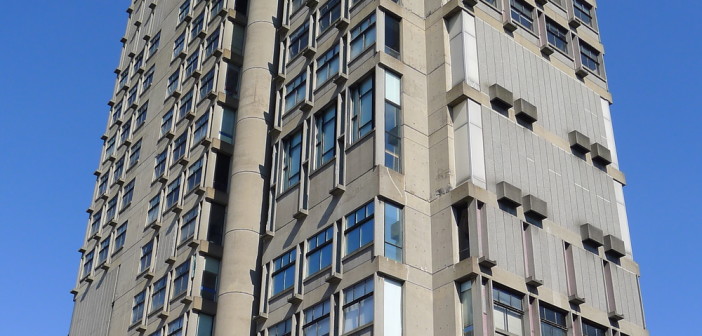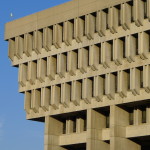For the past two years, I have taught a course on Reviled Architecture at Boston University. The class explored a variety of buildings that frequently incite people’s ire, and my students found no lack of published sources on the subject. Last summer, for example, California Home + Design Magazine assembled a list of "25 buildings that should be demolished right now," which joins compendiums of ugliest/worst/most-hated buildings from Forbes, New York magazine, HRH the Prince of Wales, Virtual Tourist, Esquire, and CNN, among many others. The problems with these rankings are obvious. In the first place, most are little more than provocative unpopularity contests that offer more in the way of attention-getting value than they do substantive critical dialogue. Moreover, there seem to be no objective criteria for assessing a building's (lack of) architectural merit: these lists are often based only on subjective value-judgments. Also missing is a consensus on who should be the arbiters of taste. Some rankings are based on wide-open online polls, others on more selective surveys (only locals or only architects, for instance), while a few are simply editors’ unilateral picks. Despite their inherent shortcomings, these lists nevertheless raise some intriguing and important questions about the nature of architecture in society, the reasons why certain buildings are widely hated, as well as what to do about unpopular architecture.
My students would discover early in the semester that (to take a riff on Tolstoy) all beloved buildings are the same, but each hated building is hated in its own way. That is to say that "great" buildings usually adhere to the formula that Vitruvius codified long ago: firmitas (structural soundness), utilitas (functionality), and venustas (beauty). But when it comes to hated buildings, the reasons for their unpopularity are more varied and complex.
Many buildings, for instance, are hated not because of their inherent architectural qualities (firmitas, utilitas, venustas), but rather because of how the buildings relate to their physical contexts. In this regard, hating a building is different from hating, say, a painting. If a painting clashes with the color of a room, it is easy enough to take a brush and change the wall color or, easier still, to move the painting. But a building is stuck in place once it is built, becoming an integral part of the environment, defining a space, and affecting the experiences of people who inhabit it. Whereas the value of a Picasso does not diminish if an owner hangs it in a room where it doesn’t fit in, a building’s reputation depends in large part on how it relates to its surroundings.
A prime example is the Pan Am (now MetLife) building in Manhattan, designed in 1958 by Emery Roth & Sons, Pietro Belluschi, and Walter Gropius. Few admire the building’s aesthetics ("gigantically second-rate" is how New York Times critic Ada Louise Huxtable described it1), but it is chiefly condemned for its location and the physical and social effects on its immediate surroundings--viz., Grand Central Station and Park Avenue. Even before construction had finished, detractors resented that the massive skyscraper would add hundreds of thousands of people to the already overcrowded Grand Central area as it simultaneously blocked the view of Park Avenue. Yale architectural historian Vincent Scully noted in his 1963 article The Death of the Street that Pan Am "visually denies the continuity of the Avenue beyond Grand Central, deprecates the length of the Avenue’s axis of movement, and smothers its scale. In any terms other than those of brute expediency, it should not be there at all."2 Even 25 years later, most people still seemed to agree with Scully’s assessment. A 1987 New York magazine poll of over 100 prominent New Yorkers (business leaders, government officials, celebrities) ranked the Pan Am building at the top of a list of "Buildings New Yorkers Love to Hate."3 To emphasize the point, the magazine’s cover featured an image of a giant wrecking ball smashing into the front of Pan Am.
This story brings to light another factor that contributes to architectural animosity: herd mentality. Just as peer pressure influences the clothes we wear, the movies we see, the books we read, and the stocks we buy, so too does high-profile disparagement (such as the New York magazine article heaped on the Pan Am building) go a long way towards shaping our perception of architecture. Similarly, professional critics hold sway over popular opinion. We often look to critics, as "experts," to explain concepts that we know little about, and people who don’t study architecture professionally rely on learned commentaries to help them decide what to think of a building. The dean of American architecture critics, Ada Louise Huxtable, described her role as being "largely informational and educational, to let the public know what’s going on in the large and small issues and to let them know the difference between good and bad--how to distinguish a work of art."4 While this public scrutiny is useful in many ways, it comes at a cost: the media spotlight shines on real and perceived deficiencies of a few buildings, even as many others (sometimes equally bad or worse) benefit from remaining shrouded in obscurity so as to escape attention.
Symbolism is another force shaping public opinion about architecture. Like Pan Am, Minoru Yamasaki’s infamous Pruitt-Igoe public housing complex in St. Louis suffered from a host of sociological shortcomings that led to crime and depopulation. But Pruitt-Igoe also came to be hated for what it symbolized: the public-policy failure of top-down autocratic approaches to social problems without input from the people whose lives are actually affected. It came to be regarded not only as a discrete failure to address the needs of the urban poor in St. Louis, but also a broader symbolic failure of the Modernist approach to urban renewal and city planning. So powerful was the antipathy towards Pruitt-Igoe that it was demolished in 1972 (only 20 years after it opened), and so profound was the symbolic resonance of the building and its demolition that Charles Jencks famously pronounced the event "the day Modern architecture died."5
Another distinctly symbolic failure is the Ryugyong Hotel in Pyongyang, North Korea, which Esquire named the "worst building in the history of mankind."6 Begun in 1987, the building was intended to stand as a symbol of North Korea’s cultural and economic strength. In the wake of the Soviet Union’s collapse, the North Korean economy weakened, and construction stopped abruptly in 1992; it would not resume for 18 years. During that time, a host of problems came to light, including faulty engineering and cost overruns (either of which alone would have made for a hated building). But the hotel is most criticized for its symbolism. The 105-story behemoth rises from one of the poorest neighborhoods in the city and has come to represent a dysfunctional economy and an oppressive regime that has lavished untold resources on this calamitous project while the majority of North Koreans are believed to suffer from chronic food shortages. Not since the Domus Aurea--Nero’s infamously opulent palace that came to symbolize his corruption and vice--has a building been associated with a ruler’s hubristic insensitivity to the needs of the people.
This is not to suggest, of course, that the Vitruvian ideals of firmitas, utilitas, and venustas play no role in hated architecture. The CLA building at Cal Poly Pomona, for instance, is an example of how structural deficiencies can undermine a building’s reputation. The CLA building sits directly above the San Jose Hills fault, and campus administrators claim that it is dangerously under-prepared for an earthquake (a claim that the architect, Antoine Predock, denies). Other structural problems, such as persistent leaks, have plagued the facility since its completion in 1993. Aesthetically, the CLA building has few detractors; in fact, its iconic triangular silhouette simulates the mountain peaks that surround the campus and is even featured prominently in the school’s logo. Nevertheless, the CSU Board of Trustees has approved a plan to demolish and replace the building.
Similarly, the trio of buildings at Boston University designed by José Luis Sert have garnered criticism for structural shortcomings. The late John Silber, who served as Boston University's president for 25 years, vigorously derided Sert’s designs in his 2007 book, Architecture of the Absurd. Silber wrote disparagingly, for example, of the library’s entrance: "Thinking perhaps of balmy Spain, Sert designed a large, unprotected entrance to the Mugar Library facing northeast towards the Charles River. The brutal nor’easters of Boston made this entrance unusable."7 According to Silber, the poor design led to flooding on the ground floor when rain and snow would blow in during a storm. As BU’s president, Silber hired architects to seal the old entrance and create a new one that faced south. Silber rebuked Sert’s design for the neighboring student union building, too, writing that the large open patio at the center of the building frequently filled with rain and snow, leaking into the cafeteria below.
Silber also criticized Sert’s Law School. Because of the tower’s orientation on a north-south axis, Silber complained, "On a clear winter day the east side is comfortably warmed by the morning sun while the west side suffers from the cold. In the afternoon the situation is reversed."8 He moreover deplored the ill-fitting steel ventilation panels, which made the building drafty and leaky, and he criticized the fact that only small transom windows can be opened, requiring expensive scaffolding when the windows need cleaning.
Vitruvius’s second dictum, functionality, also figures prominently in Architecture of the Absurd. For example, Silber derides Frank Gehry’s Stata Center at MIT for its functional deficiencies. These include shortcomings that are both economic (construction ran $215 million over budget at a time when MIT was cutting expenses) as well as experiential (the offices have glass walls so that workers are constantly distracted by foot traffic in the hallways). Silber also criticizes Gehry’s use of glass walls in laboratory areas where top-secret military and industrial research is carried out, such as at MIT’s Cryptography and Information Sharing Group, which is charged with developing secure information systems. "Thanks to the design of their building," Silber writes, the scientists "may inadvertently share more information than they secure."9
This brings us, at last, to the most common criticism of hated buildings: ugliness. Every architectural style has fallen out of fashion at some point. As Ada Louise Huxtable wrote, "Tastes change as surely as the seasons, only it takes a little longer."10 During the Renaissance, the great Gothic cathedrals were objects of scorn. Renaissance and Baroque (or, as John Ruskin called it, "Grotesque Renaissance") architecture was then hated at the height of the Gothic Revival, only to be celebrated again during the Beaux-Arts period. When Modernism came along, all historicism--including Beaux-Arts and High Victorian Gothic--was anathema, and Modernism itself only recently emerged from a reputational slump brought about by Post-Modernism.
The most hated architectural style of today is Brutalism--the anti-rational movement that sprang from late-Modernism in the mid-1950s, characterized by sculpturally dramatic, often monumental, raw concrete designs. Now between 40 and 60 years old, Brutalist buildings are suffering from the ravages of middle-age: they’ve lost their novelty but aren’t yet old enough to be considered valuable as antiques. The most frequent criticism of Brutalism is that it is "ugly." Certainly, Brutalist buildings are provocative; they are intentionally (in the words of one of the great proponents of the style, the late Gerhard Kallmann) "difficult" in that they "do not immediately appeal to the senses."11 But the concept of ugliness is problematic. Not only is it inherently subjective, but also it is difficult to define--it’s an omnibus word that carries different meanings for different people.
Kallmann’s own Boston City Hall, designed in 1962 with N. Michael McKinnell and Edward Knowles, is a case in point. It frequently makes the "most-hated" lists, recently topping the 2012 California Home + Design lineup of "25 buildings to demolish right now." It is perennially criticized by Bostonians, and even the city’s mayor has twice proposed selling or preferably tearing down the building. Many say the building is "ugly," but there is little consensus on what makes it so. For example, some deplore the massive concrete City Hall for differing formally from Boston’s historic landmarks (such as nearby Faneuil Hall) and the genteel, red-brick buildings of the type found in abundance on Beacon Hill and in the Back Bay. Others object to the bold use of concrete, which rapidly fell out of favor as a primary building material in the 1970s. (It surely doesn’t help that the building has suffered from decades of neglect and deferred maintenance that have left the concrete crumbling and dirty.) Still others oppose the building for not "looking like a city hall;" there are no Corinthian columns, soaring domes, or other iconography ("pompous pratfalls to the classical past," as Huxtable put it12) that we generally associates with monumental government buildings.
Of all the reasons for hating a building, these aesthetic objections are the most ephemeral. Even in the case of Boston City Hall, which Virtual Tourist once named the "ugliest building in the world," respect has begun to increase.13 For instance, in 2007, the Boston Landmarks Commission received a petition to grant the building landmark status, and concerned citizens formed an advocacy group, Friends of Boston City Hall. As Noah Cross shrewdly observed in the movie Chinatown, "Politicians, ugly buildings, and whores--they all get respectable if they last long enough." In other words, very few hated buildings are hated forever. In fact, some of the most reviled buildings from the past—including the Eiffel Tower, the Washington Monument, and the Twin Towers—are now some of the most beloved.
Unfortunately, other hated buildings did not last long enough to outgrow their unpopularity. New York’s Penn Station, McKim, Mead, and White's 1910 reproduction of the Roman Baths of Caracalla for the Pennsylvania Railroad, fell on hard times in the early 1950s. There was a small but influential group of preservation-minded citizens who eventually tried to save the building, but the tide of public opinion was against them. Penn Station was demolished only 53 years after it opened and replaced with an austere, utilitarian, subterranean waiting room, topped by a new Madison Square Garden. Now, of course, New Yorkers long for the old monumental Beaux-Arts gateway to the city, while Madison Square Garden is itself reviled ("a graceless, sloppy, cheap entertainment and office complex that would be an insult to an empty site in the middle of nowhere," wrote The New Yorker’s Paul Goldberger).14
Similarly, Edward Durrell Stone's bizarrely eclectic 1964 Gallery of Modern Art at 2 Columbus Circle (which Huxtable once called "a provocatively misplaced pleasure pavilion transplanted from some Shalimar garden to a Manhattan traffic island"15) ranked seventh on New York magazine’s 1987 list of most hated New York buildings. During the last decade, the facade was completely replaced and bears no resemblance to Stone's original Modernist-meets-Mughal design. Now the critics are out in force longing for what was lost: James Gardner of the New York Sun wrote, "Say what you want about Stone’s building, it was indubitably a landmark; the best that can be said for its replacement is that, if we’re lucky, no one will ever notice it."16
What, then, are we to do with hated buildings? On one side of the issue is a bloc of detractors ready to see the wrecking balls swing. Among them is the President of the the Royal Institute of British Architects (RIBA), George Ferguson, who in 2004 proposed establishing a Grade X listing of the "most vile" buildings in the UK. While the idea received some popular support after a BBC Channel 4 reality show invited the public to choose an ugly building to be demolished on national television, others balked. An article in Apollo Magazine called Ferguson’s suggestion "philistine" and "knee-jerk prejudice" while pointing out that "the history of taste--of changing perceptions of vileness and ugliness--is rather less straightforward than the President of the RIBA would have us believe."17
But at the same time that high-profile unpopularity contests seek to tear them down, there is also a growing movement to preserve these spurned buildings. Organizations such as Docomomo (the International Committee for Documentation and Conservation of Buildings, Sites and Neighbourhoods of the Modern Movement), Britain’s Twentieth Century Society, and local preservation groups have come to see in the reviled architecture of today an analogue to the unfairly hated buildings of the past--from Penn Station to Louis Sullivan’s Chicago Stock Exchange. As such, many Brutalist buildings have made their way onto landmarks registers, effectively staving off the bulldozers. Critics are quick to counter, however, that preservation of unwanted buildings is often cost-prohibitive and infringes on private property rights.
There are no easy answers to the complex questions of preservation, and it would be wrongheaded to generalize about thousands of specific cases with unique circumstances. But the pages of architectural history are rife with cautionary tales, and many a regret has grown out of the rubble of a too-hastily demolished building. At the very least, society would do well to avoid any rash decisions and to foster a deliberate, informed critical dialogue that moves beyond promulgating fleeting biases and derogatory hype.
- Pruitt-Igoe demolition
- MIT Stata Center
- Boston City Hall
- Boston City Hall
- Boston City Hall
- BU Mugar Library and George Sherman Union
- BU Law Tower
- BU Law Tower
[1]Ada Louise Huxtable, "Architecture Stumbles On," New York Times, April 14, 1963, p. 119.
[2]Vincent Scully, Jr., "The Death of the Street," Perspecta 8 (1963), p. 95.
[3]Richard David Story, "The Buildings New Yorkers Love to Hate," New York, June 15, 1987, p. 30.
[4]Cathy Lang Ho, "On Criticism," The Architects Newspaper, Nov. 16, 2005, accessed September 17, 2012, http://archpaper.com/news/articles.asp?id=149.
[5]Charles Jencks, The Language of Post-Modern Architecture (New York: Rizzoli, 1984), p. 9.
[6]Eva Hagberg, "The Worst Building in the History of Mankind," Esquire, January 28, 2008, accessed September 17, 2012, http://www.esquire.com/the-side/DESIGN/hotel-of-doom-012808.
[7]John Silber, Architecture of the Absurd (New York: Quantuck Lane Press, 2007), p. 48.
[8]Ibid.
[9]Ibid., p. 87.
[10]Ada Louise Huxtable, "The Beauty in Brutalism, Restored and Updated," Wall Street Journal, February 25, 2009.
[11]Gerhard Kallmann, "The Action Architecture of a New Generation," Architecture Forum 4 (1959), p. 137.
[12]Ada Louise Huxtable, On Architecture: Collected Reflections on a Century of Change (New York: Walker, 2008), p. 50.
[13]"The World’s Top 10 Ugliest Buildings," Virtual Tourist, accessed September 17, 2012, http://members.virtualtourist.com/vt/t/1c7/.
[14]Christopher Gray, "Is Penn Station’s Killer Significant? Or Unforgivable?" New York Times, October 16, 2005.
[15]Ada Louise Huxtable, On Architecture: Collected Reflections on a Century of Change (New York: Walker, 2008), p. 38.
[16]James Gardner, "Missing the Marble at 2 Columbus Circle," New York Sun, April 15, 2008.
[17]Gavin Stamp, "Anti-Ugly," Apollo, January 2005, p. 89.















